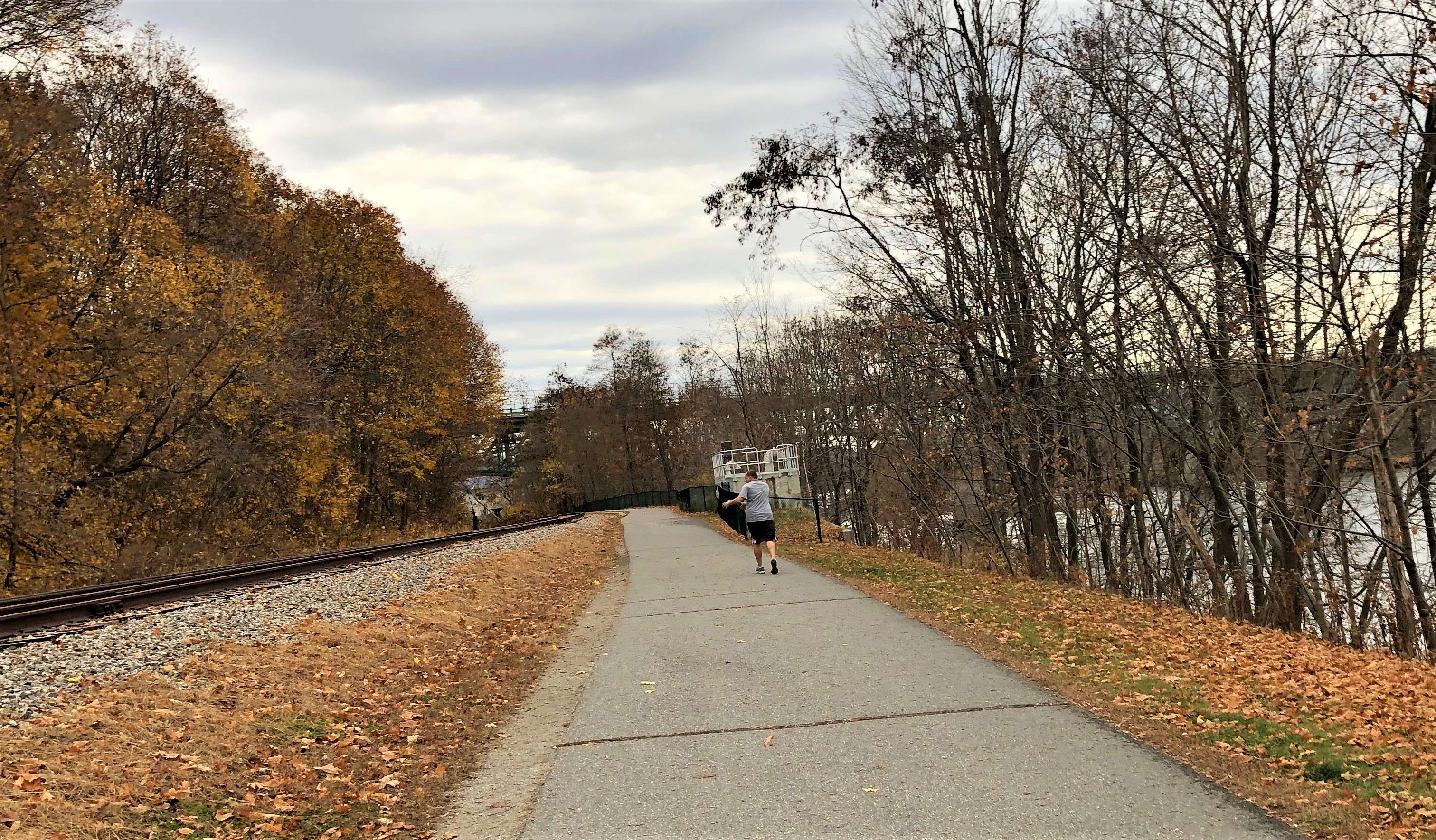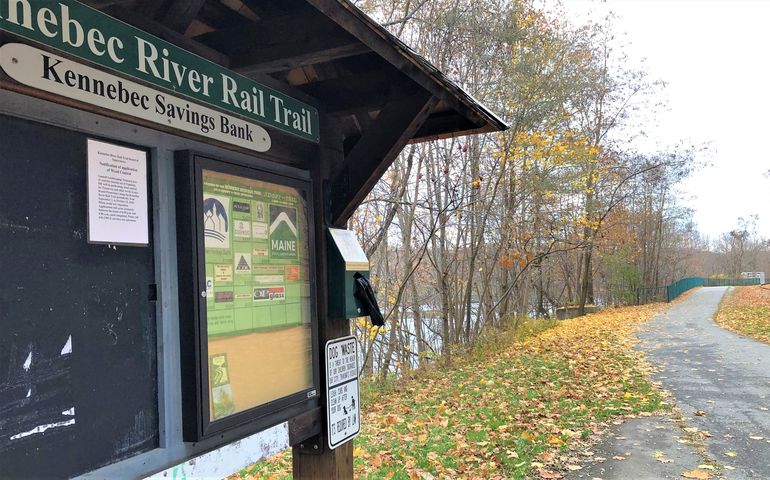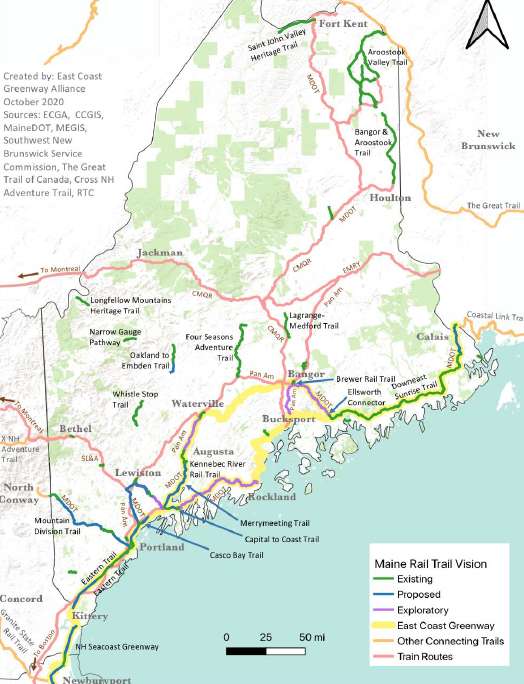
Plan calls for network of multi-use rail trails across Maine by 2030
 Photo / Maureen Milliken
The Kennebec River Rail Trail, which runs along the rive for 6.5 miles between Augusta and Gardiner, could be part of a 13-trail statewide network in a plan recently launched by the Maine Trail Coalition.
Photo / Maureen Milliken
The Kennebec River Rail Trail, which runs along the rive for 6.5 miles between Augusta and Gardiner, could be part of a 13-trail statewide network in a plan recently launched by the Maine Trail Coalition.
More Information
A 10-year plan that calls for a laser focus on adding up to 250 miles to the state's rail trails and creating a connected statewide network of multi-use rail trails has been published by the Maine Trails Coalition.
The plan also preserves rail lines for reuse by trains, something favored by the the majority of Mainers in a poll by the coalition.
The Maine Rail-Trail Plan 2020-2030 plan calls for construction of 13 specific rail-trail projects over the next decade, and at least five more developed over the next decade. Each of the projects connects with and extends existing multi-use trails, and creates regional connections between communities across the state, the coalition said.
The plan comes at the brink of profound societal and environmental changes that make it a critical part of future planning, said Sue Ellen Bordwell, chair of the MTC rail-trail working group. "A regional trail network is critical to public health, community, and the urgent need for emission-free transportation alternatives to reverse climate change," Bordwell said.
The plan is a first step in envisioning the possibilities for a statewide network of multi-use trails that can connect residents to community assets, open space, employment, transit and other destinations, including schools and health care centers, the coalition said in a news release.
The coalition was formed last year and is seeking ways to capitalize on the state's unused rail corridors, as well as draw visitors and boost economic development, both in rural areas and downtowns.
Moving forward with rail-trail development would also capitalize on Maine’s brand as an outdoor recreation destination, attracting visitors to rural and urban Main Streets and businesses.

Mainers strongly support rail trails
The idea is one supported by a large majority of Mainers regardless of political leaning, according to a poll commissioned last year by the Maine Trails Coalition. Some 86% of Mainers support creating multi-use trails on unused rail corridors as long as they can be converted back to railroad use if needed. The poll shows 87% of Democrats polled strong agree, as do 83% of Republicans and 88% of independent voters.
In addition to their public health, environmental and community benefits, regional trail systems provide a multifold return on investment in the form of local economic impact and tourism, the MTC said.
The plan calls for continuing to preserve and maintain a separate and active rail corridor that can be used to extend future Amtrak, commuter train, or freight service from Boston through Maine's largest population centers.
The plan lists 37 existing trails and 13 more, most in southern and central Maine. Another 13 that could be constructed, connecting the existing trails, range in length from a 32-mile Oakland-to-Embden trail in Kennebec and Somerset counties, and a 31-mile Gorham-to-Fryeburg trail in Cumberland and Oxford counties, to a 1-mile Ellsworth connector.
The five exploratory trails connect regions, and many are part of the East Coast Greenway. The plan, in fact, would bring much of the northern end of the 3,000-mile East Coast Greenway close to completion. The proposed projects in the plan would nearly completed the corridor from the New Hampshire border to Waterville, and from Bangor to Calais, put more than 80% of Maine’s ECG corridor off-road and safe from car traffic for those using it.
The greenway has become the most visited “park” in America, according to the trails coalition. The East Coast Greenway, once completed, would be a fully connected bike and walking path, safe from cars, that runs from the top of Maine to the bottom of Florida. Roughly 1,000 miles have been built to date, and the remaining 2,000 miles are in various stages of visioning, planning and design at the local, regional, and state levels.
The plan illustrates that the most important inter-urban corridors don't require a choice between trains and trails, but that there are alternate routes that allow for both, the coalition said.
"A regional multi-use trail network is complementary to expanding transit in Maine and can provide connections from where people live to transit, increasing the potential service area for future passenger rail," it said.
The coalition said it plans to refine the plan over time as communities, regional authorities, state agencies and other interest groups weigh in.











0 Comments